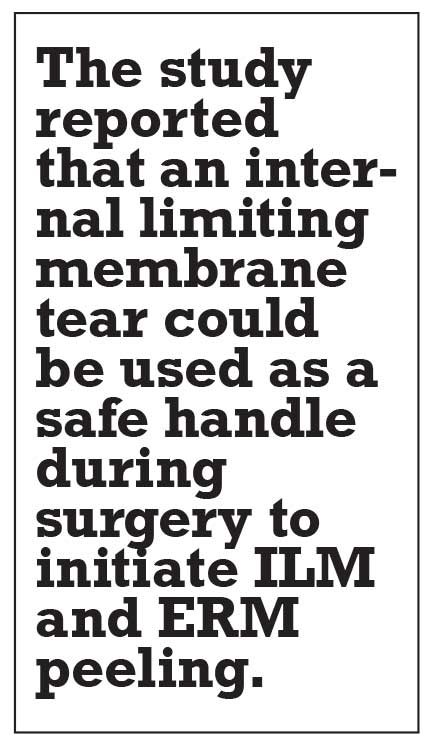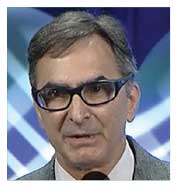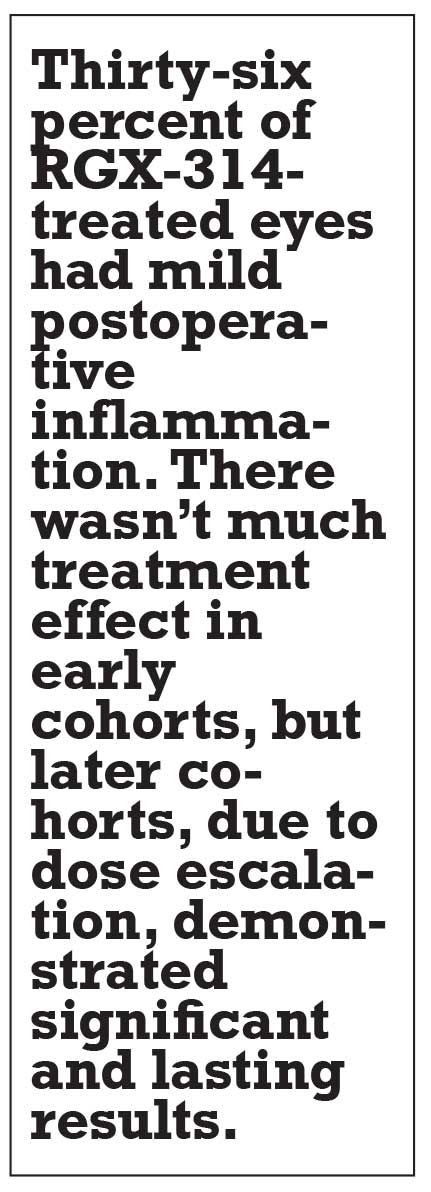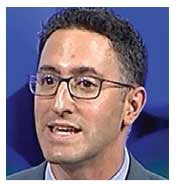 |
Take-home Points
|
 |
|
Bio Dr. Finn is assistant professor of clinical ophthalmology and visual sciences at the |
The annual meeting of the American Academy of Ophthalmology and the Retina Subspecialty Day affiliated with it returned to a live format in New Orleans in November, and the clinical science presented during the sessions showed that the COVID-19 pandemic, while it may have slowed some clinical trials and studies, hasn’t sidetrack them completely.
Here we present five notable abstracts from the meeting: results of a retrospective review of giant internal limiting membrane tears with epiretinal membranes; updates from two Phase III trials evaluating faricimab for diabetic macular edema; a pilot study evaluating light therapy for DME; a readout of a trial of an adeno-associated virus (AAV) vector for neovascular age-related macular edema; and a report on dosing errors using the aflibercept prefilled syringe.
New insights into giant ILM tears
 |
Dr. Mark Johnson: Large ILM tears associated with ERMs often go unrecognized and are rarely discussed, Mark Johnson, MD, reported. This review of 23 eyes defined a giant ILM tear as a dehiscence large enough to result in a curved and scrolled edge of ILM.1 Dr. Johnson and colleagues hypothesized ERM contracture contributes to the pathogenesis of these tears because they’re usually located at the edge of the contracted ERM.
In this retrospective review of cases from 2016 to 2019, Dr. Johnson and his team identified ILM tears in 23 of 71 eyes with ERM. They found that radial cuts on preoperative optical coherence tomography allowed for increased detection of ILM tears and that virtually all of the ILM tears were convex with an edge pointing toward the fovea. High myopia was more common in eyes with ILM tears.
 |
Associated features included nerve fiber layer schisis, inner retinal dimpling in the area with absent ILM (likely due to Muller cell injury), and perivascular red lesions consistent with intraretinal cavitations or inner lamellar defects. The suspected tears were confirmed with intraoperative Brilliant Blue G (DORC)staining. Dr. Johnson stated that the ILM tear could be used as a safe handle during surgery to initiate ILM and ERM peeling.
Dr. Johnson has no relevant relationships to disclose.
Faricimab DME Phase III readout
 |
Dr. Jeffrey Heier: Faricimab, now known as Vabysmo (Genentech/Roche), is a bispecific antibody that inhibits both vascular endothelial growth factor and angiotensin 2 (Ang-2), which has the potential to increase treatment durability and efficacy. YOSEMITE and RHINE are two identical double-masked studies that enrolled almost 1,900 patients with center-involving DME and visual acuity of 20/40 or worse.2 Patients were randomized to faricimab q8 weeks after six loading doses, faricimab personalized treatment interval (PTI) after four loading doses, or aflibercept q8 weeks after five loading doses. The primary endpoint was mean best-corrected visual acuity over weeks 48, 52 and 56.
Both trials met the primary endpoint, showing faricimab noninferiority to aflibercept with eyes gaining 10.5 to 11.2 letters at one year. Further, Jeffrey Heier, MD, noted that more than half of eyes in the PTI arm achieved q16-week dosing and 72 percent achieved q12-week or longer dosing. Pooled data demonstrated greater reductions in central subfield thickness in the faricimab-treated group compared to aflibercept, which was maintained through week 56.
A post hoc analysis showed eyes treated with faricimab achieved this absence of DME (defined as CST <325 µm) earlier than aflibercept-treated eyes—and more faricimab eyes (90 percent) achieved this endpoint than aflibercept eyes (80 percent). Rates of ocular and nonocular adverse events were low, with no reports of retinal vasculitis or occlusive retinitis. Intraocular inflammation rates were 1.3 to 1.4 percent in the faricimab arms vs. 0.6 percent in the aflibercept arm.
Dr. Heier disclosed relationships with Regeneron Pharmaceuticals, Genentech/Roche, Novartis, Bayer and Chengdu Kanghong Biotechnology.
Photobiomodulation therapy for DME
 |
Dr. Judy Kim: Judy Kim, MD, presented results from the DRCR Retina Network pilot study evaluating photobiomodulation (PBM).3 PBM is irradiation by light in the far-red to near-infrared light spectrum (630-900 nm). The literature has reported some beneficial effects of PBM on improved wound healing, apoptosis and oxidative stress reduction, and reduced leukostasis and expression of ICAM-1, which is involved in capillary permeability in animal models. Additionally, two small clinical studies suggested a potential benefit of PBM for DME.
This Phase II study enrolled 135 eyes with good vision (VA 20/25 or better) and center-involved DME, randomizing them to PBM (n=69) or placebo (n=66). Baseline characteristics were well balanced between the two arms. Eyes receiving PBM were treated morning and night for 90 seconds at a time with active treatment emitting light at 670 nm at a dose of 4.5 J/cm2 with an irradiance area not greater than 50 mW/cm.2 Patients were seen monthly for four months, with mean CST measured at month four.
While device compliance was excellent with no reported significant treatment fatigue, the study found no significant difference in CST at month four between the two groups. There was an overall 13-µm gain in CST in the PBM group and 15-µm gain the placebo group. At four months, 90 percent of the PBM and 86 of the placebo group had persistent DME. There was no significant VA change or gain over time; in fact, both groups had a ≥5-letter decline over the four months. Dr. Kim said the results didn’t support moving onto a Phase III trial at this dosing frequency.
Dr. Kim disclosed relationships with Genentech/Roche, Novartis and Regeneron Pharmaceuticals.
Two-year gene therapy results in nAMD
 |
Dr. Robert Avery: RGX-314 (RegenxBio) uses an AAV8 vector to deliver an anti-VEGF Fab. The procedure is being evaluated in the operating room via a subretinal route or in the clinic via a suprachoroidal route. The Phase I/IIa study enrolled 42 patients in five dose-escalation cohorts.4
 |
This study is now complete with two-year follow-up. Participants had to be heavily treated with a response to anti-VEGF treatment. They received a single injection of RGX-314 via a subretinal route and overall, the treatment was well-tolerated. The most common ocular adverse event was retinal pigmentary changes, noted to be mild in 62 percent of patients, but severe in two eyes, both of which had atrophy prior to enrollment.
Thirty-six percent of eyes had postoperative inflammation, which was mild in all cases. Robert Avery, MD, noted there wasn’t much treatment effect in cohorts 1 and 2. However, due to dose escalation, cohorts 3 through 5 demonstrated significant and lasting results. Due to these positive results, the Phase III Atmosphere trial is now enrolling. In the trial, two arms are receiving RGX-314 via a subretinal dose; monthly ranibizumab (Lucentis, Genentech/Roche) is the comparator.
Two suprachoroidal studies of RGX-314 are ongoing in patients with nAMD and nonproliferative diabetic retinopathy. Dr. Avery presented six-month data for AAVIATE, the Phase II nAMD trial, which enrolled dose-escalation cohorts compared to monthly ranibizumab. The trial so far hasn’t shown any significant difference in BCVA between the two arms. Most impressive was the more-than-70 percent reduction in previous treatment burden in the RGX-314 arms, with 30 to 40 percent of patients not requiring any additional treatment. Thus far, the effect has been durable with eyes maintaining good vision over the six months. Mild IOI and episcleritis were noted but resolved with topical treatment alone.
Dr. Avery also touched on the ALTITUDE study enrolling patients with severe NPDR and PDR. Fifteen eyes received suprachoroidal treatment with no IOI and only one case of episcleritis. A greater than two-step Diabetic Retinopathy Severity Scale improvement was seen in 33 percent of treated eyes and none in the observation arm at three months.
Dr. Avery disclosed he is a consultant to RegenxBio and Adverum.
Aflibercept prefilled syringe dosing errors
 |
Dr. Roger Goldberg: The pre-filled syringe (PFS) potentially offers improved efficiency given the large number of intravitreal injections performed in the United States. Upon releasing the pre-filled syringe for aflibercept, the Food and Drug Administration required Regeneron Pharmaceuticals to perform a usability study of a single injection in at least 30 patients showing accurate dosing of the labeled dose. Since the release of the PFS, transient vision loss, intraocular pressure rise and transient central retinal artery occlusion have been reported.
Roger Goldberg, MD, and his team searched the FDA’s adverse events reporting system and found 19,592 adverse events reported in relation to intravitreal aflibercept with 1,137 related to IOP increase, ocular hypertension or transient blindness. Since the release of PFS late in 2020, 160 of these adverse events were labeled “a device use issue” with the majority (151) reported in Europe. The European authorities released a letter citing a sevenfold increased risk of IOP elevation using the pre-filled syringe compared to the luer-lock syringe citing “incorrect preparation of the syringe.”
Dr. Goldberg and his team analyzed the etiologies for the variability in the volume delivered with the PFS. The aflibercept PFS has nearly a 2-mm greater internal diameter than the ranibizumab PFS. Additionally, the dose mark thickness is three times that of the ranibizumab syringe. The thickness of the dose mark alone can account for almost a 24 µL difference in the dosage given.
In an experiment to measure dosing variability, Dr. Goldberg and his team placed the PFS plunger at three insertion levels: the proximal edge of the dose mark; the distal edge of dose mark; and the plunger cone tip at distal edge of dose mark. They tested each scenario three times and showed variability in positioning related to the dose mark thickness could lead to nearly a 50-percent increased dose, and variability in the cone tip alignment could lead to a 120-percent increase in dose delivered.
Dr. Goldberg noted that dose-setting errors with the aflibercept PFS can lead to marked increases in delivered volume due to the wide internal diameter, wide dose mark, and misalignment of the cone tip. Proper adherence to the instructions for use can minimize dose-volume errors, and industrial design of these syringes is very important, he added.
Dr. Goldberg disclosed relationships with Genentech/Roche and Regeneron Pharmaceuticals. RS
REFERENCES
1. Johnson MW, Durrani AF, Hyde RA. Giant internal limiting membrane tears in eyes with a visually significant epiretinal membrane undergoing pars plana vitrectomy with internal limiting membrane peeling. Paper presented at the American Academy of Ophthalmology Retina Subspecialty Day; New Orleans, LA; November 12, 2021.
2. Heier J. Faricimab diabetic macular edema Phase 3 trial. Paper presented at AAO Retina Subspecialty Day; New Orleans, LA; November 13, 2021.
3. Kim J. Photobiomodulation therapy for diabetic macular edema. Paper presented at AAO Retina Subspecialty Day, New Orleans, LA; November 13, 2021.
4. Avery RA. Two-year results from the subretinal RGX-314 gene therapy Phase 1/2a study for the treatment of nAMD, and an update on suprachoroidal trials. Paper presented AAO Retina Subspecialty Day; New Orleans, LA; November 12, 2021.
5. Goldberg RA. Dosing errors with the Aflibercept pre-filled Syringe. Paper presented at AAO Retina Subspecialty Day; New Orleans, LA; November 12, 2021.



